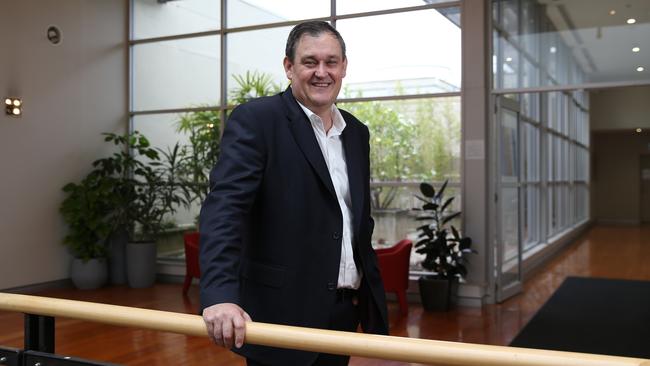Alinta forced back to drawing board on offshore wind after government intervention
The energy major’s plans have been up-ended after the Albanese government unexpectedly announced projects must be located further from the coast.
Business
Don't miss out on the headlines from Business. Followed categories will be added to My News.
Alinta has been forced to alter its plans for a giant offshore wind project off the Victorian coast after federal Energy Minister Chris Bowen unexpectedly removed the region it was looking to develop in from a proposed zone allowed to host the zero-emission energy source.
The project, known as Spinifex, is a key focus for the company.
Alinta, Australia’s fourth-largest energy retailer, has proposed a 1000 megawatt offshore wind project to provide a sizeable part of Victoria’s energy needs and meet demand from heavy users, most notably Alcoa and CITIC’s Portland smelter, which uses nearly 10 per cent of Victoria’s total electricity supply.
To advance the project, Alinta has in recent weeks been trying to sell a minority stake in Spinifex to potential partners, with first bids due this month.
But plans have been up-ended after Mr Bowen late last month excluded the region where Alinta had proposed to develop, forcing the company to reconsider its options.
An Alinta spokesman confirmed the company has had to revise its plans. “The federal government announced a proposal for a Southern Ocean wind farm zone to be established between Port MacDonnell in South Australia and Warrnambool in Victoria. As a result, we’re reviewing alternative potential locations for the Spinifex Offshore Wind Farm within the proposed zone,” he said.
“We welcome the government’s announcement, and the opportunity it’ll provide for the community, including traditional custodian groups, to have their say about appropriate areas for offshore wind farms, and the potential benefits and impacts of the renewable energy projects. We’ll continue to pursue opportunities to work collectively with the community on the project.”
Alinta had planned for the Spinifex project to be located as close as 10km off Portland’s coast, where ocean depths of 30m to 60m would allow the company to install wind turbines attached the sea bed.
But following opposition from Indigenous groups with spiritual connections to the region, and other community groups, Mr Bowen has proposed that no developments be permitted within 20km of Portland.

Alinta now faces potentially expensive changes. The company could move the project further from shore, but this would force it to use floating wind turbines which are expensive and not yet commercially viable.
The cost curve for floating turbines is, however, falling quickly, and Alinta could proceed with its offshore wind farm in the expectation that the technology will continue to mature.
With significant capital and time already invested in the project, the unexpected changes forced on Alinta are unlikely to improve relations between the company and Mr Bowen.
Alinta chief executive Jeff Dimery has been a vocal critic of efforts to accelerate the closures of coal power stations, warning that sufficient generation must first be in place, and he angered the Labor government last year when he warned of soaring power pills.
Prices did rise more than 20 per cent for tens of thousands of households, but the government has said its intervention through coal price caps limited the increases.
The government is also in a bind, because pushing the Portland wind project further from shore will hinder the development of an industry that Mr Bowen is a particular supporter of.
The Labor government has moved to aggressively develop the industry, proposing six regions around Australia’s coast in a bid to accelerate the development of an offshore wind industry to help wean the country off its dependency on coal. Coal is still the dominant source of Australia’s electricity, but Labor has legislated a target of having renewable energy provide more than 80 per cent of the country’s power needs by the end of 2030, a key pillar in Labor’s plan to reach net-zero by 2050.
Offshore wind, which is widely used around the world, offers scale that onshore wind and solar cannot match – and a plethora of global heavyweights and local giants are all clamouring to develop their own projects.
Victoria is the most aggressive. Last year, it set a target of generating about 20 per cent of its energy needs from offshore wind within a decade.
More than three dozen applications have been lodged with the National Offshore Petroleum Titles Administrator for a feasibility licence to develop in Gippsland.
Only a handful of licences are expected to be awarded, with the first expected within months.
More Coverage
Originally published as Alinta forced back to drawing board on offshore wind after government intervention





